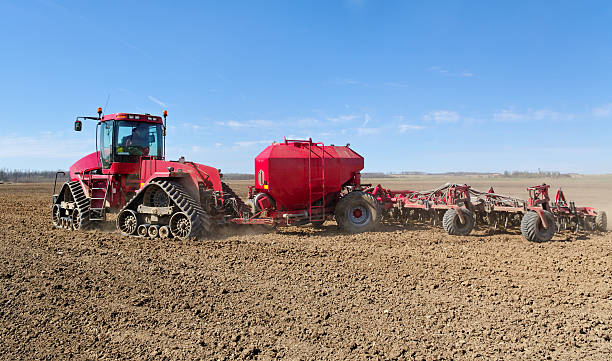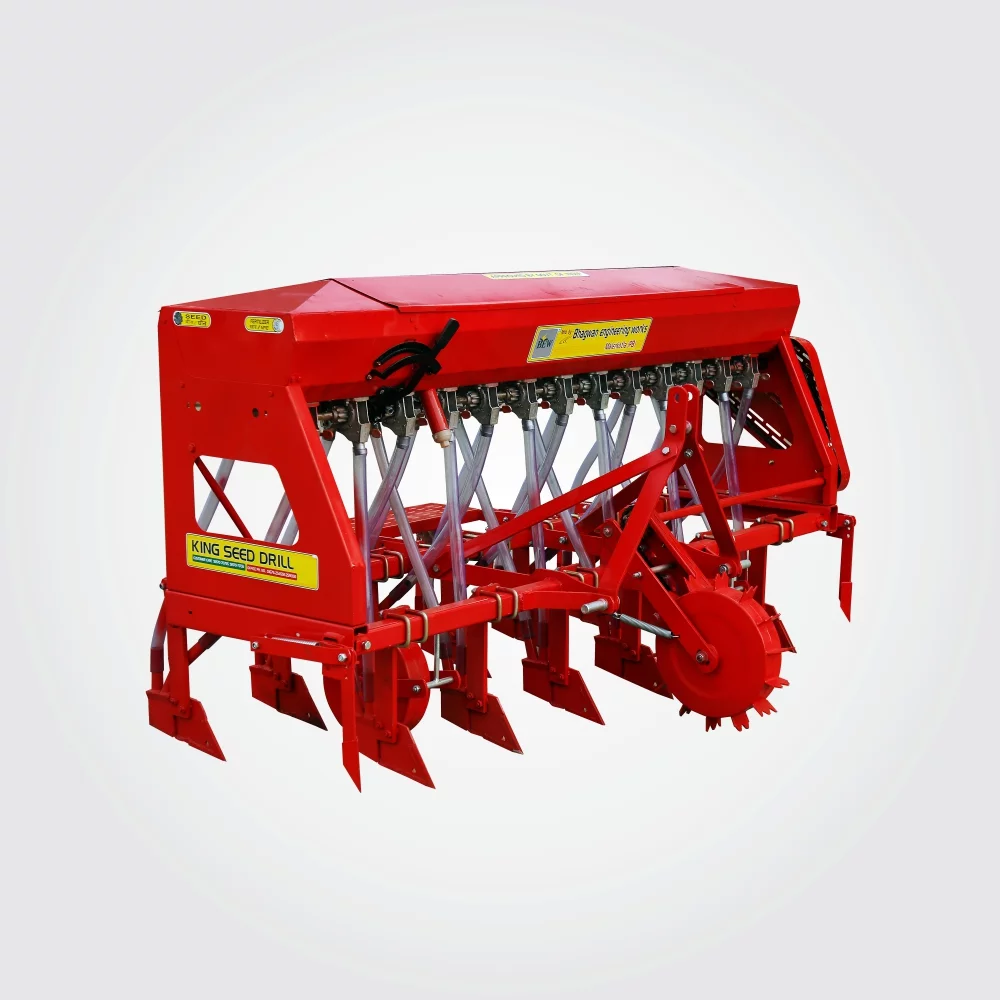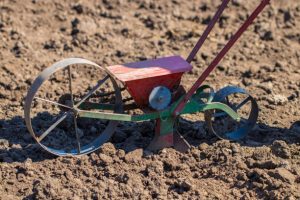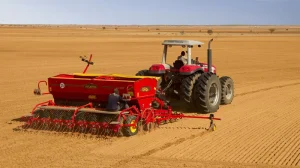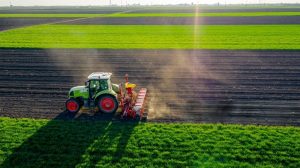Seed drills have revolutionized agriculture, providing farmers with efficient and precise methods for sowing seeds. In this article, we will explore the various types of seed drills, their features, benefits, and challenges. Understanding the differences between traditional, no-till, and air seed drills is crucial for farmers seeking to optimize their crop production.
Table of Contents
ToggleTypes of Seed Drills
Seed drills are essential tools in agriculture, facilitating the efficient sowing of seeds. Different types of seed drills have evolved, each with its unique features and advantages. Understanding these types is crucial for farmers seeking to optimize their planting methods. Here are three prominent types of seed drills:
1. Traditional Seed Drills
Traditional seed drills have been a cornerstone in agriculture for many years. These drills operate using mechanical mechanisms to sow seeds at a consistent depth. They are known for their simplicity and cost-effectiveness. However, their adaptability to different field conditions may be limited. Farmers often choose traditional seed drills for their reliability in well-tilled and leveled fields.
Pros:
- Cost-effective
- Well-established technology
- Suitable for certain field conditions
Cons:
- Limited adaptability
- May not be ideal for no-till or uneven terrains
2. No-Till Seed Drills
No-till seed drills represent a significant advancement in sustainable farming practices. Unlike traditional drills, no-till drills disturb the soil minimally, preserving its structure and health. These drills are particularly beneficial in reducing erosion, conserving moisture, and promoting overall soil health. Farmers embracing no-till practices appreciate the environmental sustainability and long-term benefits of this type of seed drill.
Pros:
- Soil conservation
- Reduced erosion
- Conservation of moisture
- Sustainable farming practices
Cons:
- Requires adaptation in farming practices
- Initial learning curve
3. Air Seed Drills
Air seed drills utilize a pneumatic system to deliver seeds with precision into the soil. This technology allows for flexibility in seed placement, making them suitable for various crops. Air seed drills are known for their efficiency in seed distribution and are often chosen for their accuracy and uniformity in planting.
Pros:
- Precise seed placement
- Suitable for various crops
- Efficient seed distribution
Cons:
- Higher initial investment
- Requires a certain level of expertise
Each type of seed drill has advantages and limitations, making it essential for farmers to consider their specific needs, field conditions, and budget constraints when selecting the most suitable seed drill for their farming operation. The choice of a seed drill significantly influences the overall efficiency and success of the planting process.
Considerations Before Choosing a Seed Drill
Before farmers invest in a seed drill, several crucial factors should be taken into account to ensure the chosen equipment aligns with their specific needs. Making an informed decision requires a thoughtful evaluation of various considerations.
A. Field Conditions
The first and foremost consideration is the nature of the field where the seed drill will be employed. Different seed drills may perform better under specific conditions. For instance, traditional seed drills may be well-suited for well-tilled and leveled fields, while no-till drills could be more adaptive to uneven or minimally prepared terrain. Analyzing the topography, soil composition, and existing vegetation in the field is imperative.
B. Crop Type
The type of crops a farmer intends to cultivate plays a pivotal role in selecting the appropriate seed drill. Some seed drills are designed for particular crops or seed sizes, ensuring optimal placement and spacing. Understanding the compatibility of the chosen seed drill with the intended crops is crucial for maximizing efficiency and achieving desirable yields.
C. Budget Constraints
While advanced seed drills come with a range of features and capabilities, it’s essential to align the investment with the available budget. Farmers should carefully assess their financial resources and explore seed drill options that offer the best balance between affordability and required functionality. Consideration of long-term benefits versus initial costs is vital in making a cost-effective decision.
By thoroughly evaluating these considerations—field conditions, crop type, and budget constraints—farmers can make informed choices that lead to the successful adoption of seed drill technology, enhancing overall agricultural efficiency and productivity.
Benefits of Using Seed Drills
Seed drills have become indispensable tools in agriculture, revolutionizing the way farmers sow seeds. The adoption of seed drills brings forth a myriad of benefits, contributing to increased efficiency, resource conservation, and improved crop yields. Here are some key advantages of using seed drills:
1. Increased Efficiency
One of the primary advantages of using seed drills is the significant increase in planting efficiency. Seed drills are designed to precisely place seeds at the desired depth and spacing, eliminating the need for manual sowing. This automation not only saves time but also ensures uniform seed distribution across the field. As a result, farmers can cover larger areas in less time, optimizing their overall workflow.
2. Conservation of Resources
Seed drills play a crucial role in resource conservation, particularly in the case of no-till and minimum-till drills. By minimizing soil disturbance during planting, these drills help preserve soil structure and reduce erosion. Additionally, the conservation of moisture becomes more effective, as the soil retains its natural composition. This not only benefits the immediate crop but also contributes to long-term soil health and sustainability.
3. Improved Crop Yield
The precision offered by seed drills has a direct impact on crop yield. By ensuring consistent seed placement and spacing, seed drills promote optimal germination and plant growth. This uniformity in plant distribution leads to better competition for resources, such as sunlight and nutrients, resulting in healthier crops. Over time, farmers often observe increased yields and improved overall crop quality.
4. Cost-Effectiveness
While the initial investment in a seed drill may seem significant, the long-term cost-effectiveness is notable. The efficiency gained through automated planting reduces labor costs and increases the overall productivity of the farm. Additionally, the conservation of resources and improved crop yield contribute to a more sustainable and economically viable agricultural operation.
5. Environmental Benefits
Seed drills, especially those aligned with no-till and minimum-till practices, offer environmental benefits. Reduced soil disturbance minimizes the release of carbon into the atmosphere, contributing to carbon sequestration. Moreover, the preservation of soil structure and reduction in erosion have positive implications for water quality, preventing sediment runoff into water bodies
Popular Seed Drill Brands
When it comes to selecting a seed drill, choosing a reputable brand is essential for ensuring quality, durability, and optimal performance. Here are two well-regarded seed drill brands known for their innovation and reliability:
1. AgriTech Precision Drills
Features:
- Precision Technology: AgriTech is known for incorporating advanced precision technology into its seed drills, allowing farmers to achieve accurate seed placement and spacing.
- Versatility: The seed drills from AgriTech are designed to be versatile, catering to a wide range of crops and field conditions.
- User-Friendly: Farmers appreciate the user-friendly interfaces of AgriTech’s seed drills, making them accessible to operators with varying levels of expertise.
User Reviews:
- Positive user reviews highlight the ease of use and reliability of AgriTech’s seed drills.
- Farmers often commend the precision and efficiency achieved with these drills, contributing to overall satisfaction.
2. HarvestPro Agricultural Solutions
Characteristics:
- Robust Construction: Seed drills from HarvestPro are renowned for their robust construction, ensuring durability even in challenging farming environments.
- Customization Options: HarvestPro offers a variety of customization options, allowing farmers to tailor their seed drills to specific cropping needs.
- Advanced Seed Placement: The brand prioritizes advanced seed placement technologies, enhancing the uniformity of seed distribution.
Customer Feedback:
- Farmers who have used seed drills from HarvestPro consistently provide positive feedback regarding the durability and longevity of the equipment.
- The customization options receive praise for allowing farmers to adapt the seed drills to their unique farming requirements.
Maintenance Tips for Seed Drills
Proper maintenance is key to maximizing the efficiency and lifespan of seed drills. Whether you have a traditional, no-till, or air seed drill, following these maintenance tips will contribute to smooth operation and successful planting seasons:
A. Regular Cleaning
Regularly clean your seed drill to remove accumulated debris, dust, and leftover seeds. Cleaning ensures that the machinery functions without obstruction, preventing potential issues during planting. Pay attention to seed tubes, colters, and other components that come directly with seeds.
B. Lubrication
Ensure all moving parts are well-lubricated to reduce friction and wear. Lubricate bearings, chains, and gears according to the manufacturer’s recommendations. Regular lubrication prevents rust formation and enhances the overall performance of the seed drill.
C. Calibration Checks
Regularly calibrate your seed drill to maintain accurate seed placement and spacing. Follow the manufacturer’s guidelines for calibration procedures, and make adjustments as needed. Proper calibration ensures uniform seed distribution across the field, leading to optimal crop growth.
D. Inspection of Wear Parts
Periodically inspect worn parts such as openers, colters, and seed tubes. Replace any worn or damaged parts promptly to prevent deterioration in planting accuracy. Checking worn parts ensures that the seed drill operates at peak efficiency.
E. Depth Adjustment
Adjust the planting depth according to the specific requirements of your crops and soil conditions. Ensure that the seed drill is set to plant seeds at the desired depth, promoting proper germination and seedling establishment.
F. Check Seed Tubes for Blockages
Inspect seed tubes for any blockages before and during planting. Blockages can disrupt seed distribution, leading to uneven planting. Clear any obstructions promptly to maintain consistent seed flow.
G. Professional Servicing
Schedule periodic professional servicing for your seed drill. This includes comprehensive inspections, adjustments, and any necessary repairs by qualified technicians. Professional servicing helps identify potential issues early on and ensures that the seed drill remains in optimal condition.
H. Storage Considerations
During the off-season, store the seed drill in a clean, dry, and sheltered environment. Protect it from harsh weather conditions and potential damage. Proper storage contributes to the longevity of the equipment.
Future Innovations in Seed Drill Technology
As agriculture continues to evolve, so does the technology that supports it. The future of seed drill technology holds exciting possibilities, with ongoing research and innovations aiming to enhance efficiency, precision, and sustainability. Here are some potential future developments in seed drill technology:
A. Precision Farming Integration
Overview: Future seed drills may see deeper integration with precision farming technologies. This could include advanced GPS systems and sensors that enable real-time monitoring and adjustment of seed placement based on specific field conditions.
Benefits:
- Enhanced precision in seed placement.
- Reduction in resource wastage.
- Improved adaptability to diverse field conditions.
B. Automation and Robotics
Overview: The future may witness the integration of automation and robotics in seed drill technology. Autonomous seed drills equipped with AI algorithms could navigate fields, make on-the-fly adjustments, and optimize planting patterns without human intervention.
Benefits:
- Increased operational efficiency.
- Reduction in labor requirements.
- 24/7 planting capabilities.
C. Smart Seed Selection
Overview: Advancements in seed genetics and technology may lead to “smart seeds” that can communicate with seed drills. These seeds could provide real-time data on soil conditions, allowing the drill to adjust planting parameters accordingly.
Benefits:
- Customized planting based on seed characteristics.
- Improved germination rates.
- Adaptive planting strategies for varying soil conditions.
D. Data Analytics for Decision-Making
Overview: Seed drills of the future may incorporate sophisticated data analytics tools. Farmers could access comprehensive insights into planting patterns, soil health, and crop performance, enabling data-driven decision-making for better yield outcomes.
Benefits:
- Informed decision-making.
- Optimal resource allocation.
- Long-term farm management planning.
E. Environmental Sensors for Sustainability
Overview: Future seed drills may integrate environmental sensors that assess the impact of planting on the ecosystem. This could include monitoring soil health, biodiversity, and carbon sequestration to promote sustainable farming practices.
Benefits:
- Enhanced environmental stewardship.
- Compliance with sustainable agriculture standards.
- Improved resilience to climate change.
F. Multi-Crop Compatibility
Overview: Innovations may focus on developing seed drills that can seamlessly switch between different crops. This adaptability could cater to diverse farming operations, allowing farmers to cultivate multiple crops in the same field.
Benefits:
- Increased crop rotation flexibility.
- Efficient use of available land.
- Diversified farming practices.
Challenges Faced by Farmers in Seed Drill Usage
While seed drills offer numerous benefits to farmers, their adoption comes with its own set of challenges. Farmers transitioning to or utilizing seed drills may encounter hurdles that require careful consideration and management. Here are some common challenges faced by farmers in seed drill usage:
A. Learning Curve
Challenge: One significant challenge is the learning curve associated with operating and maintaining seed drills, especially for farmers accustomed to traditional manual planting methods. Understanding the intricacies of the technology and its settings requires time and training.
Solution: Comprehensive training programs and workshops can help farmers familiarize themselves with seed drill operations. Providing user manuals with clear instructions and troubleshooting guides can also contribute to overcoming this challenge.
B. Initial Investment
Challenge: The upfront cost of acquiring seed drills can be a substantial barrier for some farmers. Investing in modern seed drill technology may strain budgets, particularly for small-scale or financially constrained farming operations.
Solution: Financial support programs, subsidies, and leasing options can help alleviate the burden of the initial investment. Educating farmers about the long-term benefits and cost-effectiveness of seed drills may also encourage investment.
C. Adaptation to Field Conditions
Challenge: Different seed drills may have specific requirements regarding field conditions. Farmers might find it challenging to adapt the drills to diverse terrains, soil types, or cropping systems.
Solution: Manufacturers can guide the adaptability of seed drills to various field conditions. Customization options and versatile designs in seed drill models can address the challenge of adapting to different farming environments.
D. Maintenance Complexity
Challenge: Proper maintenance is crucial for seed drill longevity, but the complexity of some drill models may pose a challenge for farmers, particularly those with limited technical expertise.
Solution: Offering user-friendly maintenance guides, accessible spare parts, and simplified designs can ease the maintenance process. Additionally, providing local technical support or services can assist farmers in addressing maintenance challenges.
E. Seed Drill Calibration
Challenge: Achieving precise seed placement and spacing requires accurate calibration of seed drills. Farmers may struggle with this process, leading to uneven distribution of seeds.
Solution: Clear and concise calibration instructions, along with user-friendly calibration tools, can assist farmers in achieving optimal seed placement. Training programs should emphasize the importance of proper calibration.
F. Variable Crop Types
Challenge: Certain seed drills may be better suited for specific crop types. Farmers cultivating diverse crops may face challenges in finding a universal seed drill that accommodates all their planting needs.
Solution: Encouraging farmers to invest in multiple seed drills tailored to different crops or promoting versatile drill models that can adapt to various crop types can address this challenge.
Conclusion
In conclusion, the comparison of different types of seed drills underscores the importance of choosing the right technology for specific farming needs. Farmers must weigh the benefits and challenges, considering factors such as field conditions, crop types, and budget constraints. The evolution of seed drills over time, coupled with real-life success stories, encourages farmers to embrace this technology for enhanced efficiency and sustainability.
Frequently Asked Questions (FAQs):
- Are seed drills suitable for all types of crops?
- Seed drills can be adapted for various crops, but their suitability depends on factors such as seed size, spacing, and soil conditions.
- What maintenance tasks are essential for seed drills?
- Regular cleaning, lubrication, and professional servicing are crucial for maintaining the efficiency and longevity of seed drills.
- Do no-till seed drills require special training for farmers?
- Yes, farmers transitioning to no-till seed drills may need training to adapt to the new planting method and maximize its benefits.
- How do seed drills contribute to environmental conservation?
- Seed drills reduce soil erosion and conserve water, promoting sustainable farming practices and minimizing environmental impact
- Can seed drills be used in small-scale farming?
- Yes, there are seed drill models designed for small-scale farming, offering efficiency and precision even on smaller plots of land.

